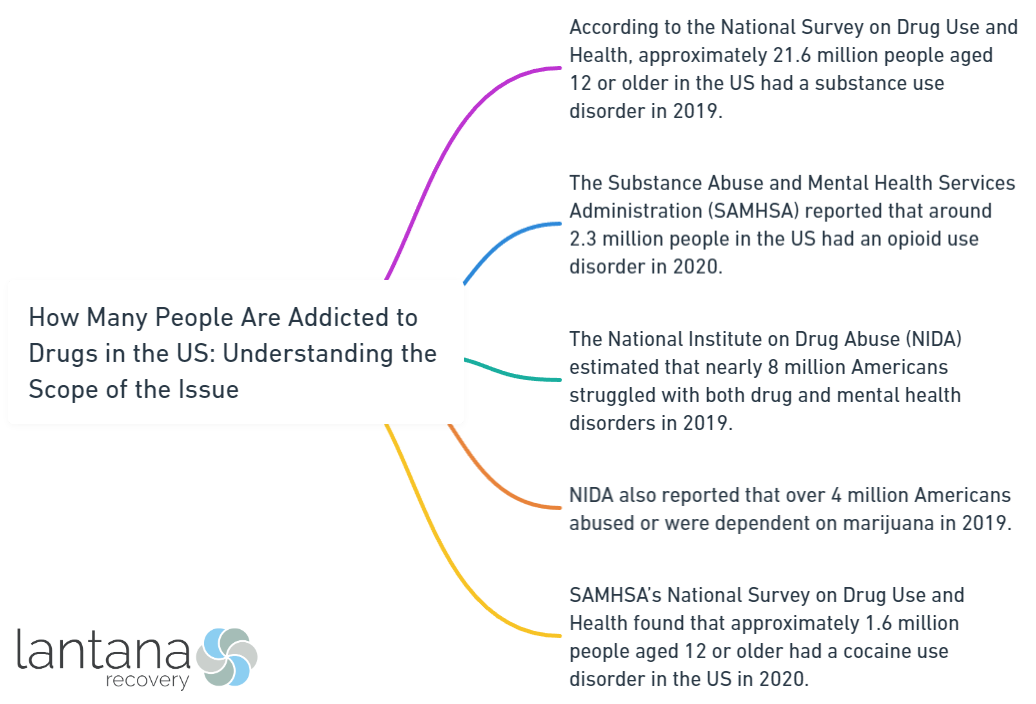Drug addiction is a prevalent issue in the United States, affecting individuals and society as a whole. Understanding the scope of the problem is crucial in order to address it effectively. Here, we delve into the prevalence of drug addiction in the US, its impact on individuals and society, factors contributing to addiction, and efforts to address this issue.
The current situation of drug addiction in the US is a growing concern. Substance abuse affects people of all ages, genders, and socio-economic backgrounds. Many individuals struggle with addiction to various substances, including opioids, stimulants, and sedatives. Drug overdose deaths have been on the rise, highlighting the urgency to tackle this problem.
The number of people addicted to drugs in the US is staggering. According to the National Survey on Drug Use and Health, approximately 19.7 million Americans aged 12 or older battled a substance use disorder in 2017. This includes both illicit drugs and prescription medications.
Certain drugs are more commonly abused than others in the US. Opioids, such as prescription painkillers and heroin, have been a major concern in recent years. Stimulants like cocaine and methamphetamine, as well as marijuana and alcohol, are also widely abused.
Drug addiction has profound physical and mental health effects on individuals. Chronic substance abuse can lead to serious health complications, including liver damage, cardiovascular problems, and mental disorders. Drug addiction can strain relationships and families, leading to conflicts, breakdowns in communication, and loss of trust.
The economic and social consequences of drug addiction are significant. The cost of healthcare, law enforcement, and lost productivity due to addiction places a burden on society as a whole. Substance abuse also contributes to crime rates, homelessness, and an overall decline in community well-being.
Several factors contribute to drug addiction in the US. Risk factors include genetic predisposition, a history of trauma or abuse, and mental health disorders. Accessibility and availability of drugs play a role, as they make it easier for individuals to obtain and misuse substances. Peer pressure and social influences can also contribute to the development of addiction.
Efforts to address drug addiction in the US are multifaceted. Treatment options, such as counseling, medication-assisted therapy, and support groups, are available to help individuals overcome addiction. Preventive measures and education programs aim to raise awareness and promote healthy behaviors. Law enforcement plays a crucial role in reducing drug trafficking and holding accountable those involved in the drug trade.
By understanding the scope of drug addiction in the US and implementing comprehensive strategies, we can work towards preventing substance abuse, providing effective treatment, and supporting individuals on their path to recovery.

The Prevalence of Drug Addiction in the US
Drug addiction is a significant issue in the United States, impacting a substantial number of individuals. The prevalence of drug addiction varies among different age groups, including young adults aged 18 to 25. Approximately 14.8% of young adults in the US struggle with addiction, as they are more likely to experiment with drugs and develop addictive behaviors.
This widespread problem has a profound impact on society, resulting in increased crime rates, strained healthcare systems, and decreased workplace productivity. The societal costs associated with drug addiction amount to billions of dollars annually.
To effectively address drug addiction, a comprehensive approach that includes prevention, treatment, and support is crucial. By investing in prevention programs and expanding access to evidence-based treatment, we can significantly reduce addiction rates and improve community well-being.
It is imperative to recognize the seriousness of drug addiction in the US and work towards comprehensive solutions to combat this public health crisis. By prioritizing prevention and treatment, we can provide much-needed assistance to individuals struggling with addiction and foster healthier and safer communities.
What is the Current Situation of Drug Addiction in the US?
The current situation of drug addiction in the US is a significant issue that affects individuals and society. It is important to understand the scope of the problem to address it effectively.
1. Drug addiction prevalence: Drug addiction is widespread in the US, affecting people of all ages, genders, and socioeconomic backgrounds. Recent studies show that about 19.7 million Americans aged 12 or older have battled a substance abuse disorder in the past year.
2. Opioid crisis: One severe aspect of drug addiction in the US is the opioid crisis. Misuse of prescription opioids and the rising use of illicit opioids like heroin and fentanyl have led to a significant increase in addiction rates and overdose deaths.
3. Impact on health: Drug addiction takes a toll on physical and mental health. Substance abuse can cause various health problems, including organ damage, infectious diseases, mental disorders, and even death.
4. Societal consequences: Drug addiction doesn’t just affect individuals, but also has wide-ranging social and economic consequences. It strains healthcare systems, disrupts families and communities, and leads to lost productivity and increased crime rates.
5. Accessibility and availability: The availability and easy access to drugs contribute to high levels of addiction in the US. Illicit drugs are often smuggled into the country, while prescription drugs can be misused due to overprescribing or diversion.
6. Prevention and treatment: Efforts to address drug addiction include prevention programs that educate the public about the risks of drug use and promote healthy alternatives. Treatment options like counseling, medication-assisted therapy, and rehabilitation programs help individuals recover from addiction.
Understanding the current situation of drug addiction in the US is crucial to develop effective strategies and provide necessary support for those struggling with addiction. It is an ongoing challenge that requires a comprehensive approach involving various stakeholders in society.
How Many People are Addicted to Drugs in the US?
Drug addiction in the United States is a serious problem that affects a significant number of people. How many people are addicted to drugs in the US? An estimated 20.4 million Americans aged 12 and older have a substance use disorder, which includes both alcohol and illicit drugs. This means that approximately 1 in 13 people in the US are addicted to drugs, representing about 7.7% of the population aged 12 or older. The prevalence of drug addiction is highest among young adults aged 18 to 25, with about 1 in 5 individuals in this age group struggling with substance abuse.
Opioids are a major concern in the US, with around 1.6 million people having an opioid use disorder that includes prescription pain relievers and illegal drugs like heroin. Misuse of prescription stimulants and marijuana is also prevalent, affecting millions of Americans.
Drug addiction impacts both individuals and society as a whole, leading to physical and mental health issues, strained relationships, increased criminal activity, and burdens on healthcare and social welfare systems.
Addressing drug addiction requires a comprehensive approach that includes prevention, treatment, and law enforcement efforts. By understanding the scope of the problem and the number of people affected, policymakers and healthcare professionals can better allocate resources to combat this public health crisis.
What are the Most Commonly Abused Drugs in the US?
The question many people often ask is, “What are the Most Commonly Abused Drugs in the US?” Well, the answer to that question includes opioids, stimulants, marijuana, alcohol, benzodiazepines, and hallucinogens. These substances have unfortunately become widely abused across the country.
Opioids, such as oxycodone and heroin, are particularly concerning due to their high addictiveness. Tragically, they are responsible for a significant number of overdose deaths each year.
Stimulant drugs, like cocaine and methamphetamine, also carry serious risks when abused. Many individuals fall into the trap of addiction, which can have severe implications for their health and well-being.
While marijuana is now legally used for recreational or medicinal purposes in many states, it is essential to remember that its abuse can still lead to negative health effects and addiction.
Alcohol, despite being legal, remains one of the most frequently abused substances. Excessive consumption can result in addiction and various health problems, including damage to the liver.
Benzodiazepines, such as Xanax and Valium, are commonly prescribed for anxiety and insomnia. Unfortunately, these drugs are highly addictive and often misused for their sedative effects.
Lastly, hallucinogens like LSD, mushrooms, and ecstasy are used recreationally for their mind-altering effects. However, they come with significant risks and can lead to addiction.
It is crucial to understand that any drug, whether legal or illegal, has the potential for abuse and addiction. Therefore, if you or someone you know is struggling with drug abuse, it is vital to seek help from a healthcare professional.

The Impact of Drug Addiction on Individuals and Society
Drug addiction profoundly affects both individuals and society. The repercussions of drug addiction are extensive, with detrimental effects on physical and mental health, impaired cognitive function, strained relationships, and compromised personal well-being. Additionally, drug addiction often results in financial instability as individuals either struggle to maintain employment or allocate a significant portion of their income to sustaining their addiction.
In the broader context of society, drug addiction contributes to a range of social issues. The prevalence of drug-related crimes is a consequence of individuals resorting to illegal activities in order to obtain drugs or finance their addiction. Furthermore, drug use places an increased burden on healthcare systems as individuals require medical attention for drug-related illnesses or injuries. Consequently, this strains resources and impairs the quality of care available to other patients.
The impact of drug addiction extends beyond the individual and healthcare systems to families and communities. Families experience emotional distress, financial burdens, and strained relationships as a result of their loved ones’ addiction. Similarly, communities face elevated crime rates, diminished productivity, and overall declines in social well-being.
Effectively addressing the impact of drug addiction necessitates a comprehensive approach centered on prevention, treatment, and support. Education and awareness campaigns play a vital role in preventing drug addiction by disseminating knowledge about the associated risks and consequences. Accessible and affordable treatment options, coupled with robust social support systems, must be made available to individuals grappling with addiction. By prioritizing the mitigation of the impact of drug addiction on both individuals and society, we can foster healthier and safer communities for all.
What are the Physical and Mental Health Effects of Drug Addiction?
Drug addiction undoubtedly has severe effects on individuals’ physical and mental health. It is important to consider various factors such as the specific drug being abused, the duration and intensity of the addiction, as they can significantly influence the nature and extent of these effects. Understanding and recognizing the impacts of drug addiction is crucial for effective intervention and support.
From a physical standpoint, drug addiction can lead to extensive damage to organs and physiological systems, including the liver, heart, lungs, and brain. The abuse of drugs can contribute to respiratory problems, cardiovascular disease, liver damage, and an increased vulnerability to infectious diseases by compromising the immune system.
In terms of mental health, drug addiction exerts a profound influence and can have a significant impact on cognitive abilities. Substance abuse often results in the development or exacerbation of conditions such as anxiety, depression, psychosis, and an increased risk of suicide. Furthermore, it impairs memory, attention, and decision-making, significantly affecting an individual’s ability to function in their daily life.
Additionally, drug addiction frequently results in detrimental social and financial consequences, such as strained relationships, isolation, unemployment, and financial instability. These factors further exacerbate the physical and mental health effects of addiction, making it challenging to break the cycle of dependence.
Understanding the physical and mental health effects of drug addiction is extremely important for the development and implementation of effective treatment and prevention strategies. This requires a comprehensive approach that includes promoting education, raising awareness, and providing accessible resources to aid individuals who are struggling with addiction in regaining control and improving their overall well-being.
The physical and mental health effects of drug addiction are not new but have been documented throughout history, from ancient civilizations to modern times. Recognizing the detrimental consequences of substance abuse has led to advancements in treatment and prevention methods. However, the battle against drug addiction continues to be a pressing issue that demands ongoing efforts and collaboration across various sectors. By prioritizing education, improving healthcare access, and creating supportive environments, societies can work towards reducing the burden caused by drug addiction and promoting overall well-being for all.
How Does Drug Addiction Affect Relationships and Families?
Drug addiction has a significant impact on relationships and families in the US. So, one may wonder: how does drug addiction affect relationships and families? Well, here are several ways in which it affects them:
1. Strained Relationships: Drug addiction not only strains the relationship between the addicted individual and their family but also breaks trust. Moreover, communication and emotional connection deteriorate as a result.
2. Emotional Distress: Families go through intense emotional distress because of their loved one’s addiction. Feelings of anger, sadness, frustration, and helplessness arise, leading to increased stress and conflicts within the family.
3. Financial Burden: Drug addiction brings about a financial strain on families. The costs associated with sustaining the addiction, including legal fees, medical bills, and the loss of income due to addiction-related issues, cause a considerable financial burden.
4. Neglect and Abuse: Substance abuse often leads to neglect and abuse within families. Addicted individuals fail in fulfilling their responsibilities as parents or caregivers, thereby affecting the well-being of both children and other family members.
5. Breakdown of Family Structure: Families experience a breakdown in both the structure and stability due to drug addiction. In some cases, parents may even lose custody or end up divorcing because of the strain caused by addiction.
6. Emotional and Psychological Trauma: Family members living with someone struggling with addiction also suffer emotional and psychological trauma. These traumatic experiences can have long-lasting effects on their mental health and overall well-being.
To address the impact of drug addiction on relationships and families, seeking support and professional help is crucial. Therapy, support groups, and educational programs can assist in healing and building healthy relationships within the family unit. Remember, recovery is possible, and with the right resources, families can find hope and support in overcoming the challenges caused by drug addiction.
What are the Economic and Social Consequences of Drug Addiction?
Drug addiction has severe economic and social consequences that impact both individuals and society as a whole. These consequences manifest in various aspects of life, affecting us economically and socially.
From an economic perspective, drug addiction incurs substantial financial costs. The healthcare system shoulders the responsibility of providing medical care and treatment for individuals suffering from addiction-related health issues. Moreover, the productivity of the workforce is hampered as addiction leads to absenteeism, reduced efficiency, and sometimes even job loss. As a result, employers face elevated healthcare expenses and may need to establish employee assistance programs to tackle the issue.
The ramifications of drug addiction extend beyond the individual, profoundly impacting society. Drug-related crimes, such as theft and violence, escalate as individuals engage in illegal activities to fund their addiction. This poses a significant threat to public safety, resulting in escalated costs for law enforcement and the criminal justice system. Additionally, drug addiction strains relationships, tears families apart, and creates social instability, causing immense suffering within families and communities.
Furthermore, drug addiction plays a role in the transmission of infectious diseases, including HIV/AIDS and Hepatitis C. This further strains healthcare systems, increasing the burden on public health resources and exacerbating public health risks.
To effectively address these economic and social consequences, it is crucial to implement comprehensive strategies that primarily focus on prevention, early intervention, and access to effective treatment programs. By investing in addiction recovery programs, education, and support services, we can assist individuals in overcoming addiction, reduce costs, and foster a more stable and productive society.

Factors Contributing to Drug Addiction in the US
Several factors contribute to drug addiction:
- Environmental factors: The environment can influence susceptibility to drug addiction. Poverty, lack of education, high crime rates, and peer pressure increase the risk.
- Genetic predisposition: Certain genes can make a person more vulnerable to addiction.
- Mental health conditions: Individuals with depression, anxiety, or post-traumatic stress disorder are more likely to turn to drugs to cope.
- Family history of addiction: Having a family member with addiction increases the risk due to genetics and environment.
- Early exposure: Experimenting with drugs or using prescription medications at a young age increases the likelihood of addiction later in life.
- Socioeconomic factors: Lower-income communities face more challenges and stressors, making them more susceptible to substance abuse.
- Lack of social support: Without a strong support system, individuals may turn to drugs to cope with loneliness or isolation.
- Availability and accessibility: Easy access to illicit substances increases the likelihood of drug abuse.
Addressing these factors holistically is important for preventing and treating drug addiction effectively.
What are the Risk Factors for Drug Addiction?
Drug addiction risk factors encompass a range of influences, such as genetics, environment, mental health conditions, peer influence, and trauma/stress. It is crucial to acknowledge that certain genes can heighten susceptibility to addiction, underscoring the need for caution among individuals with a family history.
Furthermore, residing in areas with high drug availability, experiencing poverty, or being surrounded by drug users can significantly augment the likelihood of developing an addiction.
Moreover, individuals grappling with mental health disorders are particularly vulnerable to resorting to drug use as a coping mechanism. The powerful force of peer pressure can also spur experimentation with drugs, further increasing the risk.
Furthermore, the impact of trauma or stress cannot be overlooked, as these experiences can compel individuals to turn to substance abuse in search of relief.
By comprehending these risk factors, we are empowered to take proactive measures, offering support and resources to those at risk. It is imperative that those struggling with addiction seek professional help, as there are various treatment options and support systems available to aid in their recovery and healing process.
How Does Accessibility and Availability of Drugs Contribute to Addiction?
The accessibility and availability of drugs play a significant role in contributing to addiction. When drugs are easily accessible, whether through illegal markets or over-the-counter medications, individuals can obtain and use them without much difficulty. This is especially concerning with highly addictive substances such as opioids or methamphetamine. Easy accessibility removes barriers to acquiring drugs, increasing the likelihood of addiction.
Furthermore, drug availability refers to the abundance and presence of drugs in society. When drugs are readily available, either through local dealers or online platforms, the temptation and opportunity to use them are heightened. The emergence of online marketplaces, for instance, has made it simpler for people to discreetly access drugs regardless of geographical limitations. This increased availability contributes to the proliferation of addiction and drug abuse.
Moreover, peer influence also plays a role in shaping the accessibility and availability of drugs. If individuals have friends or acquaintances who use drugs, they can easily access and experiment with drugs themselves. Peer pressure acts as a catalyst for drug experimentation, which can eventually lead to addiction.
To effectively prevent and address drug addiction, it is crucial to tackle the issue of drug accessibility and availability. This can be achieved by implementing stricter regulations on drug distribution, improving education and awareness programs, and providing support and rehabilitation for those in need. These measures will help reduce drug accessibility and availability, thereby mitigating the risk of addiction.
What Role Does Peer Pressure Play in Drug Addiction?
Peer pressure plays a significant role in drug addiction, especially among teenagers and young adults.
What role does peer pressure play in drug addiction? When surrounded by peers who use drugs, individuals may feel compelled to try drugs themselves in order to fit in and be accepted.
Peer pressure can range from subtle suggestions to direct coercion, with friends normalizing drug use or using tactics like teasing, taunting, or threatening exclusion.
It is important to note that not everyone succumbs to peer pressure, but for those who are more susceptible, it can act as a catalyst for experimenting with drugs and potentially leading to addiction.
A true story involving a teenager named Sarah illustrates the role of peer pressure in drug addiction.
Despite being a bright and ambitious student who previously made good choices, Sarah started using drugs after joining a group of friends who regularly used them.
This decision led her down a dangerous path of addiction, negatively impacting her academic performance, relationships, and overall well-being.
Sarah’s story emphasizes the importance of recognizing and resisting peer pressure to prevent the devastating effects of drug addiction.
By understanding the influence of peer pressure, we can better address drug addiction by educating individuals about the risks, promoting resilience, and fostering positive peer relationships.

Efforts to Address Drug Addiction in the US
In the United States, significant efforts have been made to address drug addiction and its impact. These efforts include:
-
Prevention programs: Organizations and government agencies have implemented programs to educate individuals, especially young people, about the risks and dangers of drug use. The aim is to raise awareness and promote healthy lifestyles as alternatives to substance abuse.
-
Treatment options: The US healthcare system offers inpatient and outpatient rehabilitation programs, counseling, medication-assisted treatment, and support groups. Access to quality and affordable treatment is a priority.
-
Law enforcement initiatives: Law enforcement agencies collaborate with stakeholders to combat drug trafficking. The focus is on targeting drug manufacturers, distributors, and dealers to reduce availability.
-
Support services: Recovery support services have been established to assist individuals in maintaining long-term recovery. These services include employment assistance, housing support, peer support, and counseling.
-
Public education and awareness: Public education campaigns aim to reduce stigma associated with drug addiction and increase awareness about available resources. The goal is to promote understanding and encourage individuals to seek help without fear of judgment.
Efforts to address drug addiction in the US require a holistic approach involving prevention, treatment, law enforcement, support services, and education. By combining these efforts, we can work towards reducing the prevalence and impact of drug addiction on individuals and society.
Communities must actively engage in these efforts and advocate for policies that prioritize addiction treatment and recovery services. By supporting evidence-based approaches and investing in effective interventions, we can foster healthier, drug-free communities and provide hope to those struggling with addiction.
What Treatment Options are Available for Drug Addiction?
Treatment options for drug addiction in the US vary and cater to the unique needs of individuals seeking recovery. Consider the specific substance being abused, the severity of addiction, and the individual’s medical and psychological history. Some available treatment options include:
1. Detoxification: This is the initial stage of treatment where the body is rid of the drug and withdrawal symptoms are managed. Medical supervision is often necessary for safety and comfort.
2. Inpatient Rehabilitation: Also called residential treatment, individuals stay at a facility for a specific duration. It provides a structured environment, intensive therapy, and support from healthcare professionals and peers.
3. Outpatient Rehabilitation: This option allows individuals to live at home while receiving treatment. They attend regular therapy sessions and educational programs that focus on relapse prevention and developing coping mechanisms.
4. Medications: Medication-assisted treatment is available for certain addictions like opioids or alcohol. These medications help reduce cravings, manage withdrawal symptoms, and aid in long-term recovery.
5. Behavioral Therapies: Evidence-based therapies like cognitive-behavioral therapy (CBT), motivational interviewing, and contingency management address the underlying causes of addiction and teach healthy coping skills to prevent relapse.
6. Support Groups: Peer support groups like Narcotics Anonymous (NA) and Alcoholics Anonymous (AA) offer a supportive community and a Twelve-Step program to promote recovery and accountability.
Remember, treatment should be individualized and may involve a combination of these options. Seek professional guidance from healthcare providers or addiction specialists to determine the most suitable treatment plan. Recovery is possible with the right support and resources.
Fact: In 2019, approximately 7.7 million adults aged 18 and older in the US needed but did not receive treatment for a substance use disorder (Substance Abuse and Mental Health Services Administration, SAMHSA).
What are the Preventive Measures and Education Programs in Place?
Preventive measures and education programs play a crucial role in addressing drug addiction in the US. These initiatives aim to educate individuals and increase awareness about the risks and consequences of drug abuse. Here are some examples of the preventive measures and education programs in place:
1. School-based prevention programs: Schools implement drug prevention programs to provide students with information about the dangers of drug use. These programs educate students on the risks associated with drug abuse and teach them important life skills to resist peer pressure.
2. Community outreach programs: Community organizations and nonprofits organize drug prevention campaigns. These programs involve events, workshops, and seminars to educate individuals of all ages about the consequences of drug abuse and promote healthy alternatives.
3. Public awareness campaigns: The government and various organizations launch campaigns to raise awareness about drug addiction. These campaigns utilize various media platforms to disseminate information and encourage individuals to seek help if they or their loved ones are struggling with addiction.
4. Prescription drug monitoring programs: Many states have implemented monitoring programs to address prescription drug abuse. These programs track and monitor the prescription of controlled substances, ensuring their appropriate use and minimizing the risk of addiction.
5. Rehabilitation and treatment centers: There are numerous centers across the country that provide support and treatment to individuals struggling with addiction. These programs focus on helping individuals overcome addiction and develop the necessary skills for a drug-free life.
By implementing these preventive measures and education programs, communities can equip individuals with the knowledge and resources to make informed decisions and prevent drug addiction. Raising awareness and providing support are crucial in addressing this widespread issue.
How Does Law Enforcement Tackle Drug Addiction?
Law enforcement plays a significant role in tackling drug addiction in the US. Their efforts are focused on preventing drug trafficking, apprehending dealers, and reducing drug-related crimes. To effectively address drug addiction, law enforcement employs several strategies:
-
Investigation and Prosecution: Officers carry out thorough investigations to identify and arrest individuals involved in drug trafficking. They gather evidence, conduct surveillance, and collaborate with other agencies to dismantle drug organizations. Prosecution ensures that those responsible are held accountable for their actions.
-
Interagency Cooperation: Law enforcement agencies work closely with organizations like the Drug Enforcement Administration (DEA). This collaboration allows for the sharing of intelligence and the coordination of efforts to combat drug addiction. By pooling resources, law enforcement can enhance the effectiveness of their operations and track drug supply chains.
-
Enforcement of Drug Laws: Officers actively enforce drug laws to deter drug-related activities. Through patrols, establishing checkpoints, and conducting searches, they identify and apprehend individuals in possession of illegal drugs. This proactive approach not only prevents crimes but also removes drugs from circulation.
-
Community Policing: Law enforcement agencies engage in community policing to educate the public about the dangers of drug addiction and encourage community involvement. Officers interact with community members, organize awareness programs, and provide resources. By building trust and gathering intelligence through community engagement, law enforcement can encourage the reporting of drug-related activities.
-
Rehabilitation and Diversion Programs: Law enforcement collaborates with stakeholders to provide rehabilitation and diversion programs for individuals struggling with addiction. These programs aim to reduce recidivism by offering treatment, counseling, and support services. By addressing the underlying causes of drug addiction and providing individuals with support, law enforcement helps them on the path to recovery.
By employing these strategies, law enforcement plays a crucial role in addressing drug addiction, promoting public safety, and protecting communities from the consequences of drug abuse. Their efforts contribute to creating a safer and healthier society.
Frequently Asked Questions
How many people in the US are addicted to drugs?
According to the reference data, over 37 million people actively use illicit substances in the United States. Additionally, 25.4% of illicit drug users in the US suffer from drug dependency or addiction.
What are some commonly abused substances in the US?
Some commonly abused substances in the US include alcohol, prescription drugs, cocaine, marijuana, and heroin. Marijuana is the most commonly used illicit substance, with nearly 50 million people using it. Furthermore, opioids, specifically prescription painkillers, are also widely abused.
How has the COVID-19 pandemic affected substance use and mental health?
The COVID-19 pandemic has had a negative impact on the nation’s mental health and substance use. The outbreak has exacerbated alcohol and drug use among past-year users. Individuals with a past-year major depressive episode and adults with any mental illness or serious mental illness were more likely to report that the pandemic negatively affected their mental health.
What initiatives are being implemented to address substance use and mental health issues?
The Biden-Harris Administration has prioritized the behavioral health needs of Americans by reestablishing the Behavioral Health Coordinating Council and distributing funding through SAMHSA’s Substance Abuse Prevention and Treatment and Community Mental Health Services block grants. SAMHSA has awarded grants to increase access to substance use disorder and mental health treatment services and address behavioral health disparities in under-resourced communities. Policy innovations, such as streamlining registration for opioid treatment programs and reducing training requirements for buprenorphine treatment, have also been implemented.
Where can I find treatment for addiction and mental health disorders?
Individuals seeking treatment for addiction and mental health disorders can find help through SAMHSA’s National Helpline or by visiting the findtreatment.samhsa.gov website. Various treatment providers, rehab facilities, and recovery centers throughout the country offer different levels of care and payment options. Online addiction therapy and treatment centers are also available. It is important to contact a treatment provider for more information and support.
Are there support groups or apps available for individuals struggling with addiction?
Yes, there are recovery support groups and apps available for individuals looking for support. These resources can provide additional guidance, motivation, and a community of people who understand the challenges of addiction. They can be a valuable part of the recovery journey.









